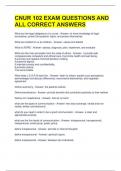CNUR 102 EXAM QUESTIONS AND
ALL CORRECT ANSWERS
What are the legal obligations of a nurse - Answer- to have knowledge of legal
boundaries, protect the patients' rights, and protect themselves
What are instilled in us as children - Answer- values and beliefs
What is ADPIE - Answer- assess, diagnose, plan, implement, and evaluate
What are the main principles from the code of ethics - Answer- 1.provide safe
compassionate competent and ethical care, 2.promote health and well being,
3.promote and respect informed decision making,
4.preserve dignity,
5.maintain privacy and confidentiality,
6.promote justice,
7.be accountable
What does L.E.A.R.N stand for - Answer- listen to others, explain your perceptions,
acknowledge and discuss differences, recommend alternatives, and negotiate
agreement
Define autonomy - Answer- the patients wishes
Define beneficence - Answer- provide benefits that contribute positively to their welfare
Define non maleficence - Answer- first do no harm
what are the types of communication - Answer- two way exchange, verbal and non
verbal, written and electronic
what do you need in order to be a good communicator - Answer- a clear and
appropriate purpose
what are the five levels of communication - Answer- intrapersonal, transpersonal,
interpersonal, small group, public group
define intrapersonal - Answer- self talk or internal thoughts
define transpersonal - Answer- spiritual inquiry
define interpersonal - Answer- between two individuals
, what are the types of interference in terms of noise - Answer- physiological,
psychological, environmental, and semantic
describe physiological noise - Answer- pain or hunger
describe psychological noise - Answer- stress, biases, anxiety, and fear
describe environmental noise - Answer- tv, bells, pumps, paging system
describe semantic noise - Answer- medical jargon, language barriers, deaf or blind
why is therapeutic communication the best for a patient - Answer- no personal feelings
are involved which leaves boundaries in tact
what are the four basic styles of communication - Answer- passive, passive aggressive,
aggressive, and assertive
describe passive communication - Answer- anxious and often fail to speak up for
themselves
describe passive aggressive communication - Answer- appear passive but aggressive
behind the scenes
describe aggressive communication - Answer- dominate others, impulsive, overbearing
describe assertive communication - Answer- speaking up without stomping on everyone
else
what are involved in non verbal communication - Answer- eye contact, gestures,
proxemics, and facial expression
what is intonation - Answer- tone of voice
what are the phases of a therapeutic relationship - Answer- pre-interaction, interaction,
working and resolution
what are some relational practice skills - Answer- empathy, trust, responsiveness, and
self aware
what does SURETY stand for - Answer- sit at an angle, uncross arms and legs, relax
what are the levels of teamwork - Answer- collaboration, shared leadership,
intersectional working, multi professional, and inter professional
what is intersectional working - Answer- support groups to help achieve a goal




